 Image search results - "katsushika" Image search results - "katsushika" |

Sando worship path to Taishakuten temple. Shibamata is in Tokyo's Katsushika Ward bordered by the Arakawa River in the west and by the Edogawa River in the east.
|
|

"Watakushi, umare mo sodachi mo Katsushika, Shibamata desu..." (I was born and raised in Shibamata, Katsushika Ward) If this opening line sounds familiar, you must be one of the many ardent fans of Tora-san movies.
|
|

The Tora-san "Otoko wa Tsurai Yo" (It's Tough Being a Man) movie series was played by the late Atsumi Kiyoshi. Tora-san is Japan's most lovable drifter and lovelorn on the silver screen. Forty-eight movies in this series were produced from 1969 to 1995. Katsushika-ku is where the Tora-san Museum is.
|
|
|

Statue of Tora-san in front of Shibamata Station. Posed like he's going to the station for another faraway trip...
|
|

Sando worship path to Taishakuten temple
|
|

This is a pose when Tora-san goes to the Shibamata Station and he looks back to his sister Sakura who calls him.
|
|

The path is lined with shops.
|
|

The first Tora-san movie came out in 1969 and over 40 more installments have been produced since then. It is entered in the Guiness Book of World Records as being the movie series with the most sequels.
|
|

Tora-ya
|
|
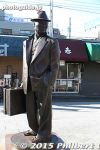
He will soon be accompanied by a statue of his sister Sakura.
|
|

Shibamata Station is on Keisei Kanamachi Line which runs between Kanamachi Station on the Japan Railways Joban Line (originating at Ueno Station) and Keisei Takasago Station on the Keisei Main Line coming from Keisei Ueno Station.
|
|

This is the shopping arcade which serves as the setting for the famous Tora-san movie series starring Atsumi Kiyoshi.
|
|
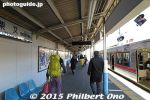
Shibamata Station platform
|
|

Shibamata Station platform
|
|

When you get to Shibamata, don't expect the quiet shitamachi charm depicted in the Tora-san movies. Expect a lot of tourists instead, especially on weekends and holidays.
|
|

Shibamata Station
|
|

Fame has brought prosperity to the shops which line the mall leading to the Shibamata Taishakuten Temple. This shop, called Kameya Honpo, apparently served as the model for the Tora-ya dumpling shop.
|
|
|
|
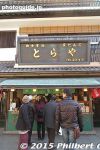
Shop called Toraya.
|
|
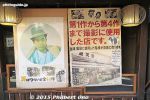
This shop was used in the early Tora-san films.
|
|
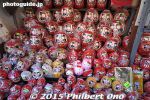
Daruma dolls
|
|

There are plans to build a statue of Sakura, Tora-san's sister, near this statue at Shibamata Station
|
|

The shop sells kusa dango (mugwort dumplings with real grass inside), the local specialty. Photo: Nitenmon Gate in view
|
|

Toward the end of the shop-lined mall, you will see this Nitenmon Gate of the Shibamata Taishakuten Temple, formally known as Daikyoji. 二天門
|
|

The plot is basically the same for each installment: middle-aged Kuruma Torajiro^ (Tora-san) meets pretty woman (the movie's leading lady whom the Japanese call the "madonna"), has a good time with her and falls in love. Photo: Tora-san Mus
|
|

Wood carvings on Nitenmon Gate
|
|

He somehow always loses her much to the dismay of his married sister Sakura (played by Baisho Chieko) and adoptive uncle and aunt who run a small kusa dango (mugwort dumpling) shop in Shibamata.Photo: Tora-san Museum 寅さん記念館
|
|

This temple serves as a recurrent backdrop in the Tora-san series. The temple's priest is played by the humorous Ryu Chishu who actually came from a family of Buddhist priests. Photo: Bell tower
|
|

He is a drifter who travels extensively all over Japan and works as street vendor/hawker selling little trinkets and what not. Photo: The stripe pattern of the walls is the same as Tora-san's coat.
|
|

The Nitenmon Gate was completed in 1896 and features wooden statues of Zocho and Komoku, two of the four Devas which guard the four cardinal directions from demons.
|
|

He returns home to Shibamata every once in a while, usually at a most inopportune time for the family, and eventually leaves in disgrace after a family argument or lost love. Photo: Map of Japan marking all the prefectures where Tora-san was filmed.
|
|

Founded in 1629 by a priest named Nitchu and his disciple Nichiei, the temple belongs to the Nichiren sect of Buddhism.
|
|

It is difficult to pinpoint exactly why the series is so popular and enduring. It's probably a combination of several elements. Photo: Summary of all movie installments
|
|

The present Naiden (Inner Sanctuary) was completed in 1915. Keyaki (zelkova) was used for all the wood in the building. The present Haiden (Worship Hall) was completed in 1929. Photo: Taishaku-do Hall 帝釈堂
|
|

The hilarious humor of the characters, the heartwarming scenes, the shitamachi charm of Shibamata, the beautiful scenery and quaintness of the places Tora-san visits, the guest stars. Map of Japan marking all the prefectures where Tora-san was filmed.
|
|

Taishakuten is the god Indra from Brahmanism, a Hindu religion. Being the god of rain and thunder, Indra was a powerful warrior god that was adopted by Buddhism as a protector. Photo: Glass wall protecting the exterior of Taishaku-do Hall.
|
|

Atsumi Kiyoshi who seems to have been born to play Tora-san. (Atsumi never seemed to age even after over 20 years in the role. Tora-san's carefree, happy-go-lucky lifestyle also appeals to many. Photo: Sculpture of Tora-san's famous hat and bag.
|
|

It was believed that Indra would step in and chase away the demons causing calamities to the followers of Buddhism. Photo: Wood Carving Gallery (admission charged)
|
|

Sculpture of Tora-san's famous hat and bag
|
|

The side and rear exterior walls of the Taishakudo are blanketed with panels of detailed woodcarvings. They are the most outstanding feature of Shibamata Taishakuten Temple.. 彫刻ギャラリー
|
|

Notice the figure on the upper right...
|
|

There are ten large carvings (each 2.27 meters by 1.27 meters) depicting scenes from the Lotus Sutra (Hokekyo).
|
|

Entrance to Tora-san Museum where Tora-san is helping to install the museum sign.
|
|

The woodcarvings were requested by the temple's 16th priest, Nissai. Through a generous donation from devoted follower Suzuki Genjiro, the project was begun.
|
|

Tora-san is helping to install the museum sign.
|
|

The first panel was completed in 1922. The carver, Kato^ Toranosuke, proposed that the remaining 9 panels be carved by renown woodcarvers living in Tokyo. A large keyaki panel was delivered to each of the nine carvers.
|
|

Tora-san is helping to install the museum sign. What a great gag. Get you laughing even before you enter.
|
|

However, in 1923, the Great Kanto Earthquake struck and these panels did not survive. A subsequent search for replacement panels was conducted nationwide.
|
|
|

In 1926, large keyaki replacement panels were finally procured and the project was back on track. The carvings were completed in 1934.
|
|
|
|

Since such large pieces of keyaki wood are very difficult to find and the carvings are so fine, the carvings are regarded as highly valuable cultural assets.
|
|

Actual film studio mockup of Kuruma-ya dumpling shop
|
|

If you want a detailed explanation (in Japanese) of the Lotus Sutra scenes depicted by the woodcarvings, buy the pamphlet that is sold at the temple's souvenir stand near the Nitenmon Gate.
|
|

葛飾 柴又 くるまや
|
|
|

Inside the studio set of Tora-san. Reconstructed with the original studio set materials used at the Ofuna movie studio.
|
|
|

Kuruma-ya dumpling shop
|
|
|

Family living room
|
|
|

Family living room
|
|
|

Inside the shop
|
|

To protect the exterior woodcarvings from the elements and to allow visitors to view them up close, the temple built a transparent, permanent scaffolding on the side and rear exterior walls of the Taishakudo.
|
|
|
|

It makes you feel like you are in an art gallery. From the front of the Taishakudo, the scaffolding is neatly concealed from view.
|
|
|
|

Kitchen where they made the dumplings.
|
|
|
|
|

Miniature shop arcade
|
|
|
|
|

Tora-san's documents
|
|
|

Tora-san's passport
|
|
|

Tora-san's personal effects
|
|
|

Contents of his famous travel bag
|
|
|

Tora-san haniwa
|
|

JR Kameari Station, south exit
|
|
|

More exhibits
|
|

JR Kameari Station, north exit
|
|
|
|

JR Kameari Station police box
|
|

Since the carved walls are two stories high, the scaffolding has upper and lower levels which allows you to view the woodcarvings on the upper and lower halves of the walls. This is the lower floor
|
|

Movie posters
|
|

Policeman character from the famous manga series, KochiKame: Tokyo Beat Cops.
|
|

Dragon
|
|

Movie posters
|
|

JR Kameari Station platform
|
|

You can walk down a corridor to the Daikyakuden (Reception Hall) made entirely of hinoki (Japanese cypress). This hall faces the lovely Suikeien Garden.
|
|

Leading ladies or the "madonna." It's quite an honor for an actress to be chosen as a madonna in a Tora-san movie
|
|

Corridor to Guest House (Dai-kyakuden)
|
|

Tora-san souvenir shop
|
|

Even the corridor has wood carvings.
|
|

After visiting the temple, most of the tourists walk to the nearby Edogawa riverbank which you often see in the Tora-san series. Road to Yagiri no Watashi (boat crossing)
|
|

Corridor of guest house 大客殿
|
|

Edogawa River. Visiting Shibamata will enable you to appreciate and understand the local settings used to film the Tora-san series.
|
|

Hina dolls in guest house room 大客殿
|
|

Many movie scenes were filmed along this riverbank.
|
|

Hina dolls in guest house room 大客殿
|
|

To Yagiri no Watashi
|
|

Hinamatsuri dolls 大客殿
|
|
|

Folding screens
|
|

The boats operate on weekends. Fare is 100 yen one way.
|
|
|

Yagiri no Watashi boat dock
|
|
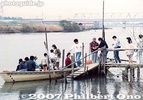
This form of public transportation dates back to the Edo Period when there were 14 locations in Tokyo where such boats operated. Only this one now remains. Boarding the Yagiri Watashi boat. 矢切の渡し
|
|
|

Yagiri no Watashi boat crossing. After the two-minute river crossing, you will be in Matsudo, Chiba Prefecture. You can then tour various temples and parks in Matsudo and neighboring Ichikawa on foot. There are signs along the way to guide you.
|
|

Garden hallway 庭園
|
|

Tea ceremony house 茶室
|
|

Suikeien Garden 庭園
|
|
|

Nitenmon Gate as seen from Taishaku-do Hall
|
|
|
|
|
|

Rear of Nitenmon Gate
|
|

Nitenmon Gate carvings
|
|

Nitenmon Gate carvings
|
|

Daishoro (bell tower)
|
|
|

Goshinsui (purification water fountain).
|
|

Goshinsui (purification water fountain).
|
|

Sacred water 御神水
|
|

Minami Daimon Gate 南大門
|
|

Hondo Hall and Shaka-do Hall
|
|

Hondo main hall 本堂
|
|

Map of temple grounds
|
|

Horikiri Shobuen Station on the Keisei Line from Ueno Station. The Horikiri Iris Garden is a short walk from here.
|
|

From the train station, just follow the paper lanterns.
|
|

Main road to the iris garden.
|
|

Horikiri Iris Garden paper lantern
|
|

Entrance to Horikiri Iris Garden. Free admission. Next to the entrance is a table with free maps of the garden and local area. Open 9 am to 4:30 pm. Closed during the year end and New Year's period.
|
|

There are little signs indicating the iris species. The non-scientific names are quite pretty. The irises are grown in numerous separate patches which are all number. The garden area is about 7,700 sq. meters.
|
|

Horikiri Iris Garden has about 200 varieties of irises and 6,000 iris plants. The garden is most famous for irises in June. However, the garden also has flowering plants throughout most of the year.
|
|

Horikiri has been famous for irises for centuries. Some hydrangea also in bloom.
|
|

Quite a crowd.
|
|

Horikiri Iris Garden, Katsushika, Tokyo
|
|
|
|

All the iris patches are numbered.
|
|
|
|
|
|
|
|
|
|
|
|
|
|
|
|

Poem on a rock
|
|

The garden also has a restaurant and tea rooms.
|
|
|

Ducky
|
|
|
|
|
|
|
|

All the irises have interesting names like "Crane's Feathers."
|
|
|
|

The garden's highest point has a small hut as seen on the left.
|
|

View from the top of the hill.
|
|
|
|

Hydrangea
|
|

Hydrangea and irises
|
|
|
|
|

Shiga's Bay Waves, Horikiri Iris Garden 滋賀浦波
|
|

Shiga's Bay Waves, Horikiri Iris Garden 滋賀浦波
|
|
|
|

Nagaragawa (Nagara River) iris
|
|
|

Another poem on a rock.
|
|
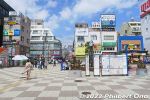
Shin-Koiwa has been transformed into a Moncchichi town. Go to JR Shin-Koiwa Station (JR Sobu Line) and see Moncchichi most everywhere. Outdoor sculptures, manholes, clock tower, escalator handrails, and bus station signs.モンチッチモニュメント
|
|
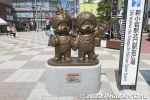
Bronze Monchicchi statue in front of JR Shin-Koiwa Station's north side (kitaguchi). Plaque reads "To all Monchicchi fans: With love and appreciation, Sekiguchi Koichi" These Moncchichi monuments were unveiled here on January 26, 2022.
|
|
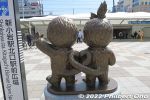
Back of the Monchicchi statue. Shin-Koiwa is where Sekiguchi Corporation, the toy company which invented Moncchichi, is based. モンチッチ像
|
|
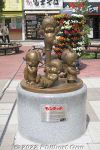
Another Monchicchi monument with seven smaller Monchicchi. These Monchicchi monuments are a good spot to meetup with friends at Shin-Koiwa Station. モンチッチ この指とまれ像
|
|
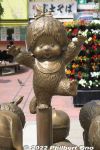
Katsushika Ward/City appointed Moncchichi as Katsushika's "PR Manager" on Dec. 2, 2012. A de facto official mascot.
|
|
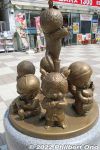
These Monchicchi monuments were donated by Sekiguchi Koichi, chairman of Sekiguchi Co., Ltd. which created Monchicchi.
|
|
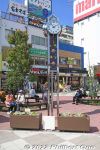
Monchicchi Clock Tower was installed in Oct. 2020 in front of JR Shin-Koiwa Station's north entrance. Tower has stained glass Monchicchi artwork. モンチッチ時計塔
|
|
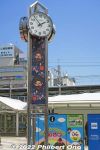
Monchicchi Clock Tower in front of JR Shin-Koiwa Station's north entrance. Lights up in the evenings. Good place to meetup in Shin-Koiwa. モンチッチ時計塔
|
|

Also at JR Shin-Koiwa Station's north entrance, a large signboard and map including directions to Monchicchi Park.
|
|
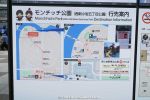
Map to Monchicchi Park, about a 15-min. walk or short bus ride.
|
|
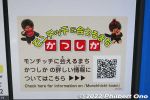
QR code for the Monchicchi web page.
|
|
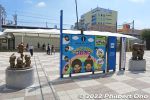
Back of the Moncchichi monuments in front of Shin-Koiwa Station, not to be confused with Koiwa Station. Shin-Koiwa Station is in Katsushika Ward while adjacent Koiwa Station is in Edogawa Ward. They are two different stations easy to mix up.
|
|
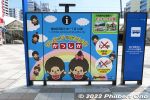
There's a boy and girl Monchicchi usually depicted as infants sucking their thumbs.
|
|
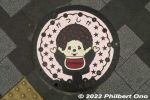
Monchicchi manhole cover near JR Shin-Koiwa Station. Moncchichi manhole covers were installed on both sides of the station in June 2017.
|
|
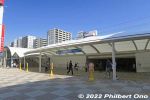
JR Shin-Koiwa Station's North Entrance (JR Sobu Line). The stairs/escalator going up to the Skydeck Tatsumi pedestrian walkway to bus stops can be seen on the left.
|
|
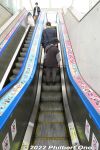
Escalator handrail decorated with Monchicchi. Way to the Skydeck Tatsumi walkway to the Tohoku Open Space Area (Tohoku Hiroba) bus stops near the train station.
|
|
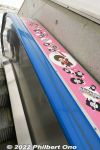
Escalator handrail decorated with Monchicchi.
|
|
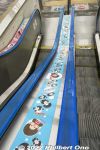
Escalator handrail decorated with Monchicchi.
|
|
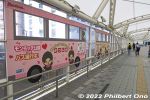
Skydeck Tatsumi pedestrian walkway to the Tohoku Open Space Area (Tohoku Hiroba) bus stops is decorated with Monchicchi. スカイデッキたつみ
|
|
|
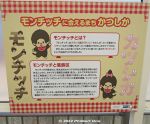
About Monchicchi and Katsushika Ward/City.
|
|
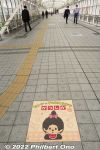
Skydeck Tatsumi pedestrian walkway to the bus stops is decorated with Monchicchi. スカイデッキたつみ
|
|
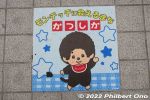
Skydeck Tatsumi pedestrian walkway floor tiles decorated with Monchicchi.
|
|
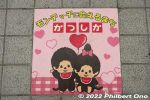
Skydeck Tatsumi pedestrian walkway floor tiles decorated with Monchicchi.
|
|
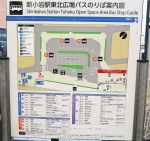
Shin-Koiwa Station's Tohoku Open Space Area (Tohoku Hiroba) bus stop map near Shin-Koiwa Station. Go to bus stop 12 to take the bus to Monchicchi Park. This is on the north side of the station. Other bus stops are elsewhere.
|
|
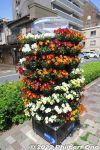
Floral decoration at Shin-Koiwa Station and bus stops.
|
|
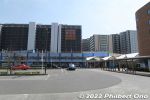
Shin-Koiwa Station's northeast Tohoku Open Space Area (Tohoku Hiroba) bus stops. Go to bus stop 12 to board the bus for Monchicchi Park. Every October, the Shin-Koiwa Station Tohoku Hiroba Festival is held here and Monchicchi also appears.
|
|
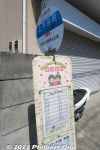
Get off here at Kami-Hiraicho stop (上平井町). Even the bus stop signs have Monchicchi.
|
|
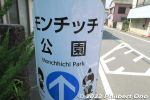
From the bus stop, follow the signs to the park entrance.
|
|
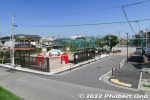
Monchicchi Park is a local public park which also serves as an emergency evacuation zone where nearby residents can seek refuge if homes are damaged in a large earthquake, etc. The new Monchicchi Zone is on the left. モンチッチ公園
|
|

The park's main area (evacuation zone) is open 24/7, but Monchicchi Zone is gated and open from 9:00 a.m. to 6:00 p.m. during April to September and 9:00 a.m. to 5:00 p.m. during Oct. to March. Closed from Dec. 29 to Jan. 3.
|
|
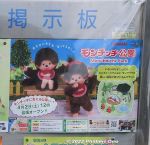
Bulletin board notice about Monchicchi Park unveiling its new expanded areas (Monchicchi Zone and Chibikko Hiroba) on April 2, 2022.
|
|
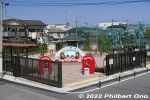
Entrance to the new Monchicchi Zone at Monchicchi Park.
|
|
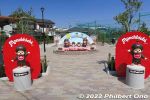
This new Monchicchi Zone has 27 Monchicchi/Sekiguchi statues all donated by the Sekiguchi Koichi, company chairman.
|
|
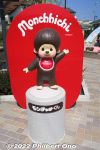
Boy Monchicchi-kun greets you.
|
|
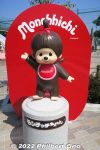
Girl Monchicchi-chan greets you.
|
|
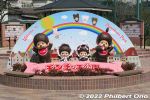
Monchicchi Zone's centerpiece monument great for selfies. Meet the Monchicchi family. On January 26, 2004, the boy and girl Moncchichi got married on Moncchichi’s 30th anniversary.
|
|
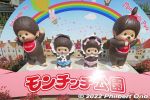
The original Moncchichi pair were fraternal twins, but were magically reinvented into a married couple. On October 30, 2004, they had fraternal twin babies (boy and girl) named “Bebichhichi” (ベビチッチ).
|
|
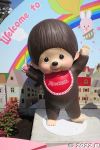
Moncchichi-kun now a dad.
|
|
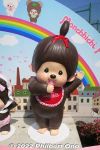
Moncchichi-chan now a mom.
|
|
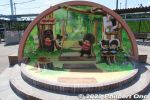
Back of the Monchicchi welcome monument is another selfie spot.
|
|
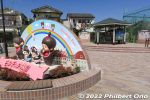
In the rear is the new Monchicchi Mini Museum.
|
|
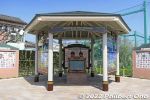
Monchicchi Mini Museum is a small open-air pavilion with a video monitor and display panels.
|
|
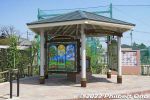
The exterior of the panels has stained glass-like artwork.
|
|
|
|
|
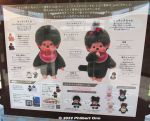
Monchicchi Mini Museum exhibit panel explaining about Monchicchi.
|
|

There's also baby Monchicchi named Bebichhichi-kun (boy on the left) and Bebichhichi-chan (girl).
|
|
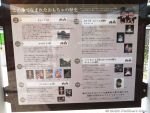
History of Sekiguchi Corporation, inventor of Monchicchi.
|
|

How Monchicchi was born.
|
|
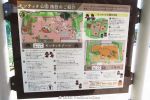
Monchicchi Park layout. Upper left is the new Monchicchi Zone and lower right is the new Chibikko Hiroba for infants.
|
|
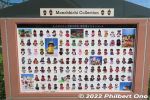
Two panels show the wide variety of Monchicchi costumes. Like Barbie dolls, Moncchichi come in an incredible variety of versions and costumes.
|
|
|
|
|
|
|
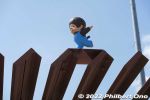
Boy Monchicchi on the roof.
|
|
|
|